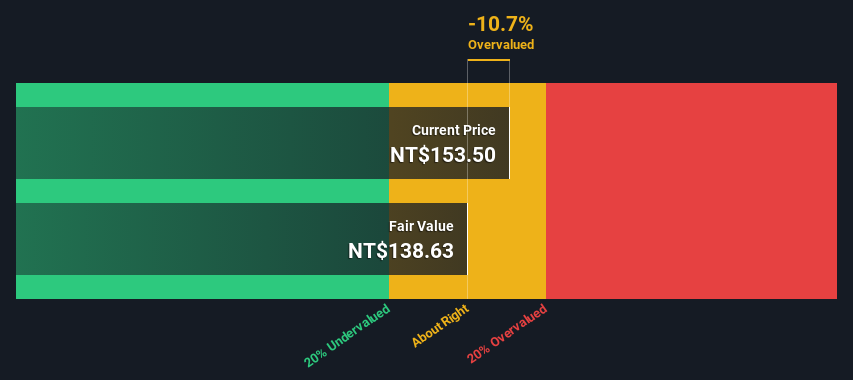A Look At The Fair Value Of Merida Industry Co., Ltd. (TWSE:9914)

Key Insights
- The projected fair value for Merida Industry is NT$139 based on 2 Stage Free Cash Flow to Equity
- With NT$154 share price, Merida Industry appears to be trading close to its estimated fair value
- Analyst price target for 9914 is NT$167, which is 21% above our fair value estimate
Does the January share price for Merida Industry Co., Ltd. (TWSE:9914) reflect what it's really worth? Today, we will estimate the stock's intrinsic value by taking the expected future cash flows and discounting them to their present value. The Discounted Cash Flow (DCF) model is the tool we will apply to do this. Models like these may appear beyond the comprehension of a lay person, but they're fairly easy to follow.
Remember though, that there are many ways to estimate a company's value, and a DCF is just one method. Anyone interested in learning a bit more about intrinsic value should have a read of the Simply Wall St analysis model.
View our latest analysis for Merida Industry
Step By Step Through The Calculation
We are going to use a two-stage DCF model, which, as the name states, takes into account two stages of growth. The first stage is generally a higher growth period which levels off heading towards the terminal value, captured in the second 'steady growth' period. To start off with, we need to estimate the next ten years of cash flows. Where possible we use analyst estimates, but when these aren't available we extrapolate the previous free cash flow (FCF) from the last estimate or reported value. We assume companies with shrinking free cash flow will slow their rate of shrinkage, and that companies with growing free cash flow will see their growth rate slow, over this period. We do this to reflect that growth tends to slow more in the early years than it does in later years.
Generally we assume that a dollar today is more valuable than a dollar in the future, so we need to discount the sum of these future cash flows to arrive at a present value estimate:
10-year free cash flow (FCF) estimate
| 2025 | 2026 | 2027 | 2028 | 2029 | 2030 | 2031 | 2032 | 2033 | 2034 | |
| Levered FCF (NT$, Millions) | NT$2.76b | NT$2.53b | NT$2.40b | NT$2.31b | NT$2.27b | NT$2.24b | NT$2.23b | NT$2.23b | NT$2.23b | NT$2.25b |
| Growth Rate Estimate Source | Analyst x2 | Analyst x3 | Est @ -5.34% | Est @ -3.42% | Est @ -2.08% | Est @ -1.14% | Est @ -0.48% | Est @ -0.02% | Est @ 0.30% | Est @ 0.52% |
| Present Value (NT$, Millions) Discounted @ 6.2% | NT$2.6k | NT$2.2k | NT$2.0k | NT$1.8k | NT$1.7k | NT$1.6k | NT$1.5k | NT$1.4k | NT$1.3k | NT$1.2k |
("Est" = FCF growth rate estimated by Simply Wall St)
Present Value of 10-year Cash Flow (PVCF) = NT$17b
After calculating the present value of future cash flows in the initial 10-year period, we need to calculate the Terminal Value, which accounts for all future cash flows beyond the first stage. The Gordon Growth formula is used to calculate Terminal Value at a future annual growth rate equal to the 5-year average of the 10-year government bond yield of 1.1%. We discount the terminal cash flows to today's value at a cost of equity of 6.2%.
Terminal Value (TV)= FCF2034 × (1 + g) ÷ (r – g) = NT$2.2b× (1 + 1.1%) ÷ (6.2%– 1.1%) = NT$44b
Present Value of Terminal Value (PVTV)= TV / (1 + r)10= NT$44b÷ ( 1 + 6.2%)10= NT$24b
The total value is the sum of cash flows for the next ten years plus the discounted terminal value, which results in the Total Equity Value, which in this case is NT$41b. The last step is to then divide the equity value by the number of shares outstanding. Compared to the current share price of NT$154, the company appears around fair value at the time of writing. Remember though, that this is just an approximate valuation, and like any complex formula - garbage in, garbage out.

Important Assumptions
The calculation above is very dependent on two assumptions. The first is the discount rate and the other is the cash flows. Part of investing is coming up with your own evaluation of a company's future performance, so try the calculation yourself and check your own assumptions. The DCF also does not consider the possible cyclicality of an industry, or a company's future capital requirements, so it does not give a full picture of a company's potential performance. Given that we are looking at Merida Industry as potential shareholders, the cost of equity is used as the discount rate, rather than the cost of capital (or weighted average cost of capital, WACC) which accounts for debt. In this calculation we've used 6.2%, which is based on a levered beta of 1.061. Beta is a measure of a stock's volatility, compared to the market as a whole. We get our beta from the industry average beta of globally comparable companies, with an imposed limit between 0.8 and 2.0, which is a reasonable range for a stable business.
SWOT Analysis for Merida Industry
- Debt is not viewed as a risk.
- Earnings declined over the past year.
- Dividend is low compared to the top 25% of dividend payers in the Leisure market.
- Expensive based on P/E ratio and estimated fair value.
- Annual earnings are forecast to grow faster than the Taiwanese market.
- Dividends are not covered by earnings.
- Annual revenue is forecast to grow slower than the Taiwanese market.
Next Steps:
Whilst important, the DCF calculation is only one of many factors that you need to assess for a company. It's not possible to obtain a foolproof valuation with a DCF model. Instead the best use for a DCF model is to test certain assumptions and theories to see if they would lead to the company being undervalued or overvalued. For instance, if the terminal value growth rate is adjusted slightly, it can dramatically alter the overall result. For Merida Industry, we've put together three pertinent aspects you should explore:
- Risks: We feel that you should assess the 1 warning sign for Merida Industry we've flagged before making an investment in the company.
- Future Earnings: How does 9914's growth rate compare to its peers and the wider market? Dig deeper into the analyst consensus number for the upcoming years by interacting with our free analyst growth expectation chart.
- Other Solid Businesses: Low debt, high returns on equity and good past performance are fundamental to a strong business. Why not explore our interactive list of stocks with solid business fundamentals to see if there are other companies you may not have considered!
PS. The Simply Wall St app conducts a discounted cash flow valuation for every stock on the TWSE every day. If you want to find the calculation for other stocks just search here.
New: Manage All Your Stock Portfolios in One Place
We've created the ultimate portfolio companion for stock investors, and it's free.
• Connect an unlimited number of Portfolios and see your total in one currency
• Be alerted to new Warning Signs or Risks via email or mobile
• Track the Fair Value of your stocks
Have feedback on this article? Concerned about the content? Get in touch with us directly. Alternatively, email editorial-team (at) simplywallst.com.
This article by Simply Wall St is general in nature. We provide commentary based on historical data and analyst forecasts only using an unbiased methodology and our articles are not intended to be financial advice. It does not constitute a recommendation to buy or sell any stock, and does not take account of your objectives, or your financial situation. We aim to bring you long-term focused analysis driven by fundamental data. Note that our analysis may not factor in the latest price-sensitive company announcements or qualitative material. Simply Wall St has no position in any stocks mentioned.
About TWSE:9914
Merida Industry
Manufactures and sells bicycles and components in Taiwan, China, Hong Kong, Japan, and Europe.
Excellent balance sheet and good value.
Similar Companies
Market Insights
Community Narratives



